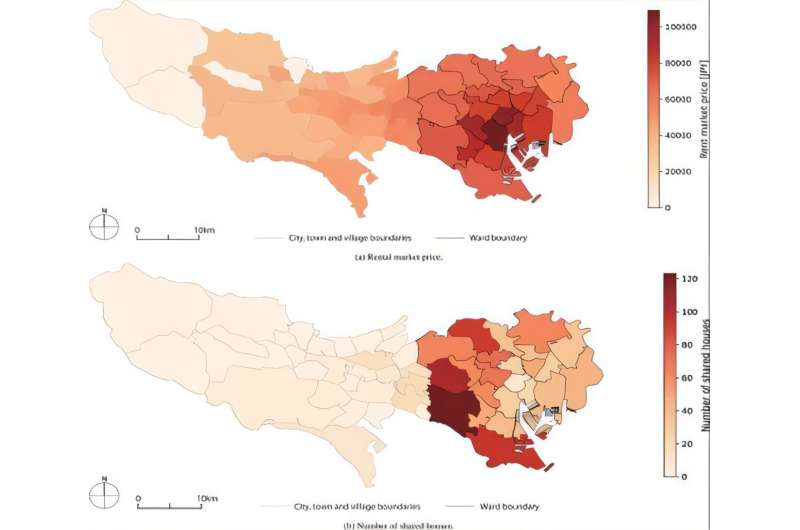
The maps illustrate differences in rental market prices (a) and the number of shared houses (b) across Tokyo’s municipalities. While rents are highest within the 23 central wards, shared houses are also concentrated in these areas, indicating that accessibility and lifestyle appeal outweigh cost in shaping their distribution. Credit: Professor Yuno Tanaka from Shibaura Institute of Technology, Tokyo
Rapid social and demographic change has reshaped how people live and connect in cities. In Tokyo, where urban density meets growing individualization, a new form of collective housing—shared houses—is redefining what home means. To understand how these spaces are marketed and perceived, researchers analyzed the descriptions of 1,374 shared houses listed by property suppliers on a major real estate website, uncovering how shared living is framed as a lifestyle choice rather than a cost-saving one.
The study, conducted by Associate Professor Yuno Tanaka from the Shibaura Institute of Technology, Tokyo, in collaboration with Dr. Kashin Sugishita from the Institute of Science Tokyo, applies large-scale text-mining analysis to explore the narratives used by property suppliers. Their findings, published in the journal Cities, reveal how the language of marketing reflects the evolving social values of urban life.
“We text-mined supplier descriptions for 1,374 properties in Tokyo—identifying 11 promotional themes—and found that shared houses are marketed as lifestyle products that emphasize safety, community, and convenience rather than cheap rent,” says Prof. Tanaka
How researchers analyzed shared housing narratives
The researchers extracted descriptive texts from Hitsuji Real Estate, a major website featuring shared houses, and used a combination of topic modeling, co-occurrence network analysis, and correspondence analysis to detect patterns across property listings. Eleven thematic clusters emerged, including “enjoyment of shared living,” “female-only and safety,” “convenience of the surrounding area,” and “common spaces.”
The results painted a diverse and nuanced picture of Tokyo’s shared housing market. Roughly half of the listed properties were mixed-sex, while nearly half were female-only—indicating both inclusivity and gender-specific considerations in housing demand. The analysis further revealed that properties near train stations frequently emphasized accessibility and neighborhood convenience, whereas those located farther away highlighted natural surroundings, interior comfort, and social interaction.
Shifting focus from affordability to experience
Interestingly, rental affordability was rarely mentioned, contradicting common assumptions that shared housing primarily appeals to those seeking cheaper rent. Instead, suppliers promoted experiential and emotional benefits—such as comfort, connection, and personal growth—suggesting a shift toward what economists call an “experience economy” in the housing sector.
“As individualization advances, shared houses offer community, safety, and move-in ease rather than only price relief,” explains Prof. Tanaka. “Our study shows how these values are strategically constructed by suppliers, expanding diverse living options in dense cities.”
Implications for urban planning and housing choice
The study’s implications extend beyond Tokyo. By analyzing how property descriptions shape perceptions of shared housing, the research demonstrates how text-mining approaches can support smarter, data-driven housing recommendations.
“In addition to conventional home searches that filter by price or location, analyzing supplier-written listing descriptions can help match properties with seekers’ preferences and reduce mismatches in property selection,” says Prof. Tanaka.
Such analyses could also inform urban regeneration strategies. The authors suggest that promoting underused properties through lifestyle-oriented narratives can bring new life to buildings in less accessible areas, potentially contributing to the revitalization of local communities.
“By enabling flexible choice among a diverse range of housing options, homes that have until now stood vacant due to disadvantages—such as poor accessibility—can be brought back into use,” notes Prof. Tanaka. “This could help rejuvenate neighborhoods and promote more inclusive urban living.”
Shared houses as a symbol of urban change
Overall, the study highlights a subtle yet powerful transformation in how housing is conceived and communicated. As Tokyo—and other global cities—grapples with aging populations, rising single-person households, and urban crowding, shared houses are emerging as a symbol of balance between privacy and community, convenience, and character.
By bridging data science and urban sociology, this research underscores that the future of city living may depend as much on how homes are described as on how they are designed.
More information:
Yuno Tanaka et al, Shared houses in Tokyo: Property characteristics and supplier promotions, Cities (2026). DOI: 10.1016/j.cities.2025.106542
Provided by
Shibaura Institute of Technology
Citation:
Beyond rent: Shared houses in Tokyo offer lifestyle, safety and community (2025, November 15)
retrieved 16 November 2025
from https://phys.org/news/2025-11-rent-houses-tokyo-lifestyle-safety.html
This document is subject to copyright. Apart from any fair dealing for the purpose of private study or research, no
part may be reproduced without the written permission. The content is provided for information purposes only.


AloJapan.com